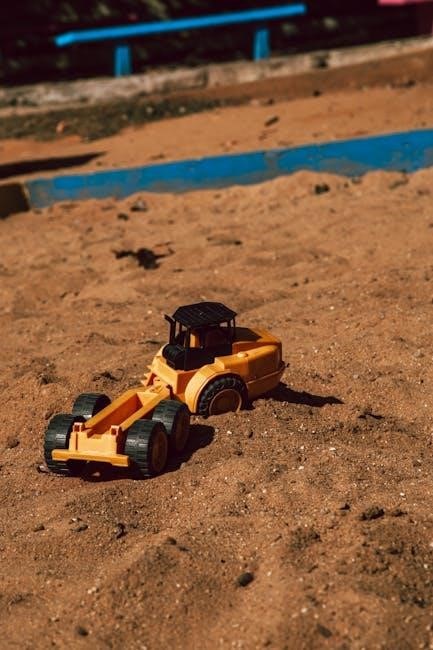Air brake systems use compressed air to apply brakes in heavy-duty vehicles, converting pressure into mechanical energy for reliable stopping power, essential for safety and regulatory compliance.
1.1 Purpose and Importance of Air Brake Systems
The primary purpose of air brake systems is to convert compressed air into mechanical energy, enabling reliable and efficient braking in heavy-duty vehicles. Their importance lies in ensuring safety, adhering to federal standards like FMVSS 121, and providing consistent stopping power for large vehicles, making them indispensable for commercial transportation and industrial applications.
1.2 Overview of Air Brake System Components
An air brake system comprises key components such as the air compressor, pressure storage tanks, brake chambers, valves, and tubing. These elements work together to store, regulate, and apply compressed air, ensuring efficient braking. Proper functionality relies on certified parts like DOT FMVSS 49CFR 571-approved tubing, ensuring safety and compliance with federal standards for heavy-duty vehicles.
Components of an Air Brake System
The system includes an air compressor, pressure storage tanks, brake chambers, valves, and tubing. These components work together to store, regulate, and apply compressed air for braking.
2.1 Air Compressor and Pressure Storage
The air compressor generates compressed air, stored in tanks for system supply. Pressure levels are monitored to ensure optimal operation, with cut-out thresholds typically between 100-130 PSI. Proper storage ensures reliable brake activation, meeting FMVSS 121 standards for safety and efficiency in heavy-duty vehicles.
2.2 Brake Chambers and Valves
Brake chambers convert compressed air into mechanical force, activating foundation brakes. Valves regulate airflow, ensuring precise control during braking. Proper chamber sizing and valve operation are critical for safe and efficient braking, adhering to federal standards for reliable performance in heavy-duty applications.
2.3 Air Brake Tubing and Fittings
Air brake tubing and fittings are critical for transmitting compressed air between components. Tubing must meet FMVSS and SAE certifications, ensuring durability and resistance to pressure. Proper sizing and material selection are essential to prevent failure. Regular inspections and maintenance are required to ensure system reliability and safety, avoiding leaks or damage that could compromise braking performance.
Working Principle of Air Brake Systems
Air brake systems function by storing compressed air in tanks, which is then transmitted through valves and lines to apply mechanical force to the vehicle’s brakes when needed.
3.1 Conversion of Compressed Air to Mechanical Energy
The air brake system converts compressed air into mechanical energy through brake chambers and valves. Compressed air, stored in tanks, is released to apply pressure on brake chambers, activating the foundation brakes. This process ensures reliable stopping power, especially in heavy-duty vehicles, by translating pneumatic energy into physical braking force efficiently and consistently.
3.2 Role of Air Pressure in Brake Activation
Air pressure is crucial for activating brakes, as it directly influences the braking force. Compressed air stored in reservoirs is released into brake chambers, applying pressure to diaphragms that activate the brakes. Proper air pressure regulation ensures consistent braking performance, preventing wheel lock-up and maintaining vehicle control. This mechanism relies on precise pressure monitoring and distribution to ensure safe and effective braking in all conditions.

Safety Standards and Regulations
Air brake systems must adhere to Federal Motor Vehicle Safety Standard (FMVSS) 121 and other regulations to ensure safety and reliability in braking performance and compliance is crucial for proper function and legal operation.
4.1 Federal Motor Vehicle Safety Standard (FMVSS) 121
FMVSS 121 sets strict guidelines for air brake systems, ensuring vehicles can stop safely under various conditions. It mandates performance requirements for braking systems, including response times and pressure thresholds. Compliance with this standard is essential for maintaining safety and meeting legal obligations in the operation of heavy-duty vehicles equipped with air brakes. Proper testing and certification are enforced to guarantee adherence. The standard is regularly updated to reflect advancements in technology and safety practices, ensuring that air brake systems remain reliable and efficient in all operational scenarios. By adhering to FMVSS 121, manufacturers and operators can ensure that their vehicles meet the highest safety standards, reducing the risk of accidents and improving overall road safety.
4.2 Compliance and Certification Requirements
Compliance with air brake system standards is mandatory, requiring adherence to federal regulations like FMVSS 121. Certification ensures components meet safety and performance criteria. Regular inspections and testing are necessary to maintain compliance, while proper documentation guarantees adherence to legal standards. Non-compliance can result in penalties, emphasizing the importance of rigorous certification processes and ongoing system validation to ensure safety and reliability.
Maintenance and Troubleshooting
Regular maintenance of air brake systems involves checking air compressor pressure, inspecting tubing, and ensuring proper air storage. Troubleshooting common issues like leaks or faulty valves is essential for reliable operation.
5.1 Regular Maintenance Practices
Regular maintenance of air brake systems ensures optimal performance. This includes inspecting air tubing for damage, checking compressor function, and testing air pressure levels. Replacing worn components like brake chambers and valves is crucial. Proper lubrication of moving parts and draining air tanks prevent moisture buildup, which can cause system malfunctions. Regular inspections help comply with safety standards and prevent unexpected failures.
5.2 Common Issues and Diagnostic Techniques
Common issues in air brake systems include air leaks, moisture buildup, and faulty valves. Diagnostic techniques involve pressure tests to identify leaks and inspecting components for wear. Visual inspections of tubing and connections are essential. Using specialized tools, technicians can measure pressure levels and ensure proper system function. Regular diagnostics help prevent sudden failures and maintain braking efficiency.

Comparison with Hydraulic Brake Systems
Air brake systems use compressed air for force application, offering scalability for heavy vehicles, while hydraulic systems rely on fluid pressure for precise control in lighter applications.
6.1 Advantages of Air Brake Systems
Air brake systems excel in heavy-duty applications due to their ability to store energy as compressed air, enabling rapid brake activation across long distances. They provide consistent braking force, are less prone to fluid leaks, and offer scalability for large vehicles. Reliability and ease of maintenance make them ideal for commercial use, ensuring safety and compliance with regulations.
6.2 Limitations and Differences
Air brake systems rely on compressed air, requiring a power source, unlike hydraulic systems. They can be slower to respond due to air travel time and are more complex, with components like compressors and valves. Air brakes are also heavier and more prone to issues like ice formation. They differ significantly from hydraulic systems in operation and maintenance requirements, needing specialized training for drivers.

Applications of Air Brake Systems
Air brake systems are widely used in heavy-duty vehicles, trains, and industrial machinery, providing reliable braking solutions for large-scale transportation and heavy equipment operations.
7.1 Use in Heavy-Duty Vehicles
Air brake systems are essential for heavy-duty vehicles, enabling reliable braking by converting compressed air into mechanical energy. They are widely used in trucks, buses, and trailers due to their ability to transmit high forces over long distances, ensuring safety and compliance with Federal Motor Vehicle Safety Standards like FMVSS 121 for over-the-road vehicles.
7.2 Application in Trains and Industrial Machinery
Air brake systems are widely used in trains to ensure synchronized braking across all cars, enhancing safety and control. In industrial machinery, they provide consistent and reliable braking performance, adapting to harsh environments. These systems are crucial for high-speed trains and heavy-duty industrial applications, ensuring precise control and efficient braking under various operational conditions.

Training and Licensing
Operating air-brake equipped vehicles requires a specific endorsement on your driver’s license. Training resources and courses are available to understand air brake systems and safety standards.
8.1 Requirements for Operating Air Brake-Equipped Vehicles
Operating air-brake equipped vehicles requires a specific endorsement on your driver’s license. Drivers must complete training programs and demonstrate understanding of air brake components, safety standards, and Federal Motor Vehicle Safety regulations to ensure compliance and safe operation of heavy-duty vehicles with air brake systems.
8.2 Training Resources and Courses
Training resources and courses for air brake systems are widely available, including PDF manuals and online tutorials. These materials cover components, safety standards, and proper techniques for operating and maintaining air brake systems. Official websites and platforms like CDL Study Manual offer comprehensive guides to help drivers and technicians understand and comply with air brake system requirements effectively.

Emergency Brake Systems
Air brake systems include emergency brakes that activate automatically in case of primary system failure, ensuring vehicle stopping through reserved air pressure, detailed in PDF guides for safety.
9.1 Functionality and Integration with Air Brakes
The emergency brake system integrates seamlessly with air brakes, utilizing reserved air pressure to activate brakes automatically in case of primary system failure. This ensures immediate stopping, enhancing safety. PDF guides detail its operation, highlighting how it interacts with service and parking brakes to maintain control during emergencies, as outlined in federal standards and technical manuals.
9.2 Emergency Brake Activation Processes
The emergency brake system activates automatically when air pressure drops below a critical threshold, engaging the brakes to halt the vehicle. This process involves the emergency valve triggering brake application using reserved air pressure, ensuring immediate stopping. PDF manuals detail this process, emphasizing its role in maintaining safety during system failures or emergencies, as required by federal safety standards.

Modern Advancements in Air Brake Technology
Modern air brake systems integrate electronic controls and IoT for enhanced performance and safety. PDF guides detail advancements like predictive maintenance and autonomous braking, improving efficiency and reliability.
10.1 Electronic Air Brake Systems
Electronic air brake systems enhance traditional setups with advanced control modules, improving efficiency and safety. These systems offer faster response times, precise control, and integration with vehicle electronics. EBS reduces stopping distances and provides real-time monitoring of brake performance. Modern PDF guides detail their operation, benefits, and troubleshooting, making them indispensable for technicians and operators seeking reliable, high-performance braking solutions.
10.2 Integration with Other Vehicle Systems
Air brake systems seamlessly integrate with modern vehicle technologies, enhancing safety and functionality. Electronic controls, anti-lock braking systems (ABS), and traction control systems work together to optimize braking performance. Real-time data sharing ensures coordinated operation, improving stability and reducing stopping distances. This integration boosts overall vehicle efficiency and driver confidence, making it a critical component of advanced vehicle safety systems.
Environmental Considerations
Air brake systems incorporate features to prevent ice formation in brake lines and adopt eco-friendly maintenance practices to minimize environmental impact.
11.1 Prevention of Ice Formation in Brake Lines
Preventing ice in brake lines involves using air dryers to remove moisture from compressed air, ensuring dry air enters storage tanks. Brake lines are designed with insulation or heating elements to maintain temperatures above freezing. Regular maintenance includes draining moisture from air tanks to prevent ice buildup. Certified tubing meeting DOT FMVSS 49CFR 571.106 and SAE J-844 standards ensures durability against cold conditions, minimizing the risk of ice formation and ensuring reliable braking performance in cold environments.
11;2 Eco-Friendly Maintenance Practices
Eco-friendly maintenance practices for air brake systems include using materials like DOT FMVSS 49CFR 571.106-approved tubing to reduce waste and ensure durability. Proper disposal of brake fluids and components is crucial. Regular inspections and timely replacements minimize environmental impact. Energy-efficient air compressors and optimized system designs further reduce energy consumption and emissions, promoting sustainability in air brake system maintenance and operation.

Resources and Documentation
Comprehensive air brake system PDF manuals and guides provide detailed technical specifications, diagrams, and maintenance procedures. Official websites and platforms offer downloadable resources, ensuring access to accurate and up-to-date information for technicians and operators.
12.1 Air Brake System PDF Manuals and Guides
Air brake system PDF manuals offer comprehensive guides, including technical specifications, diagrams, and maintenance procedures. These resources, available on official websites and platforms, cover FMVSS 121 compliance, Bendix components, and troubleshooting. They serve as essential tools for technicians, operators, and students, providing detailed insights into system operation, safety standards, and practical applications for heavy-duty vehicles and industrial equipment.
12.2 Online Courses and Tutorials
Online courses and tutorials provide in-depth training on air brake systems, covering operation, maintenance, and troubleshooting. Platforms like CDL Study Manual and Bendix offer interactive modules, videos, and quizzes. These resources help drivers and technicians understand FMVSS 121 standards, system components, and safety practices, ensuring compliance and proficiency in handling air brake-equipped vehicles and equipment.

Case Studies and Real-World Applications
Air brake systems are widely used in high-speed trains and commercial vehicles, enhancing safety and reliability in transportation. Real-world applications highlight their efficiency in heavy-duty operations, ensuring precise braking control and system durability.
13.1 Air Brake Systems in High-Speed Trains
Air brake systems are critical in high-speed trains, enabling rapid and precise braking. Compressed air is stored in reservoirs and released through electronic controls to apply brakes uniformly across multiple train cars. This ensures safety and stability at high speeds, with systems designed to maintain consistent pressure and reliable performance under varying conditions, making them indispensable for modern rail transportation.
13.2 Air Brake Systems in Commercial Vehicles
Air brake systems are essential for commercial vehicles, providing reliable braking through compressed air. These systems store energy in reservoirs, enabling quick activation of brakes across large vehicles. Federal regulations, like FMVSS 121, ensure their safety and performance, making them vital for heavy-duty trucks and buses to maintain control and prevent accidents, especially under heavy loads and varied road conditions.

Future Trends in Air Brake Technology
Electronic air brake systems and IoT integration are revolutionizing the industry, offering real-time monitoring and predictive maintenance. Autonomous braking systems are also being developed for enhanced safety and efficiency.
14.1 Predictive Maintenance and IoT Integration
Predictive maintenance and IoT integration are transforming air brake systems by enabling real-time monitoring and data analysis. Sensors and IoT devices detect potential issues before failures occur, reducing downtime and improving safety. Automated diagnostics and tailored maintenance schedules optimize system performance, ensuring compliance and reliability in modern vehicles.
14.2 Development of Autonomous Braking Systems
Autonomous braking systems integrate advanced technologies like sensors and AI to enhance safety. These systems automatically detect obstacles and apply air brakes to prevent collisions. By minimizing human error, autonomous braking improves safety and efficiency, representing a significant advancement in air brake technology for next-generation vehicles.
Air brake systems are crucial for safety and efficiency in heavy-duty vehicles. Their reliable operation ensures precise braking, making them indispensable in transportation. Proper understanding and maintenance are essential for optimal performance and compliance with safety standards.
15.1 Summary of Key Points
Air brake systems are essential for safe and efficient braking in heavy-duty vehicles. They convert compressed air into mechanical energy to activate brakes, ensuring reliable stopping power. Key components include air compressors, reservoirs, valves, and chambers. Federal standards like FMVSS 121 regulate their design and performance. Proper understanding, maintenance, and compliance with safety protocols are critical for optimal functionality and operational safety.
15.2 Final Thoughts on the Importance of Air Brake Systems
Air brake systems are vital for ensuring safety and efficiency in heavy-duty vehicles. Their ability to store and transmit compressed air enables consistent braking across large distances, making them indispensable in commercial transportation. Adhering to regulations and maintaining these systems is crucial for preventing accidents and ensuring reliable performance, underscoring their importance in modern transportation infrastructure and safety standards.






















































